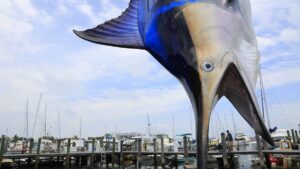Dr Boreham’s Crucible: Memphasys now feeling the investor love for its IVF tech

Pic: Charnchai / iStock / Getty Images Plus via Getty Images
Did you know that a hard-working stallion ejaculates 100 times more sperm than the average bloke?
Given a virile, but weary, thoroughbred can service hundreds of mares in a breeding season, that’s just as well. But even the most virile of these breeders can do with a helping hand when it comes to selecting the very best of the tiddlers.
Enter Memphasys (ASX:MEM), which is commercialising a novel sperm separation device called Felix to replace the current techniques that can damage the tadpoles rather than enhance the gene pool.
The equine program bears the cute title of Far Lap, but that’s a bit of a misnomer because thoroughbred artificial insemination is illegal (technically at least).
The Memphasys program is actually pitched at show horses and polo ponies, harness nags and the like.
“People pay handsomely for that sort of thing,’’ executive chair Alison Coutts says.
The company is also working on cattle breeding and there’s enough promise on the veterinary side to attract West Australian horse owner and breeder Bob Peters as a major shareholder.
“We also want to expand to other aspects of animal fertility. There are some interesting programs going on,’’ Coutts says, enigmatically.
Peters says the market is probably bigger for food production animals than for humans. He notes that with cattle and sheep, natural conception is successful only around 80 per cent of the time.
With race horses, there’s also scope for using Felix to test sperm for imperfections.
But for the time being the Memphasys emphasis is on the two-legged side of things: sperm selection for human in-vitro fertilization (IVF) procedures.
With male sperm quality declining alarmingly – one in three blokes aged over 40 is shooting blanks – humanity needs all the help it can get.
Not every sperm is sacred
Formerly known as Nusep, Memphasys is getting to the pointy end of commercialising Felix, which uses electrical separation and a membrane to sort the sperm by quality and size.
‘Good’ sperm – the tiddlers without a double head, short tail, bent neck and other flaws – has a negative charge. The membranes work by clearing “unwanted debris” such as white blood cells.
The technology was developed in league with fertility specialist Professor John Aitken, of the University of Newcastle.
The Felix devices consist of a unit in which a cartridge containing the sample is placed.
Felix intends to replace two current sperm sorting methods. One is density grading centrifuging, which is labour intensive and costly and can cause DNA damage.
The other is a laborious process called ‘swim up’, which involves the strongest sperm demonstrating that they can break out of the seminal plasma and emerge as a swimmer rather than a floater.
If it all sounds rather Darwinian, you’re right…
A tortured path to gestation
Originally known as Sperm Sorter, the device has gone through several iterations. But the company’s remit is basically the same since Nusep listed in May 2007 as a spinoff from blood products group Life Therapeutics.
“Along the way, we have had to a do a lot of engineering of the original device,” Coutts says.
“Some were pure economic reasons. The electrodes were platinumised titanium which cost $40 a pair. We have replaced it with carbon printed on to a plastic.”
The big difference between Sperm Sorter and Felix relates more to the company itself, with Nusep becoming a basket case after a promising start.
Five years ago, the company was rescued by Coutts and Andrew Goodall.
Coutts was a biotech corporate adviser who co-founded the ASX-listed mobile x-ray machine developer Micro-X.
Goodall, who is a director, left school early and founded a plant nursery in New Zealand, before successfully dabbling in property investment. “He has a sharp eye for understanding competitive advantage,” Coutts says.
Both are major shareholders, having tipped plenty of their own hard-earned cash into the company.
The path to approval
Memphasys recently took delivery of the first Felix units, manufactured by WNS Plastics (the biggest maker of plastic injected moulds in New South Wales, the company also supplies Resmed, ASX:RMD).
The units are being sent to key opinion leaders – aka IVF specialists – for appraisal.
In September last year, Memphasys struck a collaboration with ASX-listed Monash IVF, along the lines of Monash clinicians test-driving the device and providing advice.
Melbourne’s Monash IVF has already suggested that the optimal sample size is one millilitre rather than 1.8 millilitres, while the cartridge should be loaded with a single rather than dual pipetting method.
Monash IVF also has first dibs on any approved and commercial instrument.
On that note, the company plans to front the local Therapeutic Goods Administration (TGA) early next year with its plans for a clinical trial to support an approval application.
“We are working with Monash IVF to do a substantial number of in-vitro tests to compare with the current process,” says Coutts, adding the exact parameters of the trial are yet to be decided.
If the TGA says OK, Europe is next … or maybe. Coutts says the European approval process is “a bit of a menace” because of the continent’s push to tighten device approval requirements following some mishaps with faulty breast implants.
“Even devices that are already approved need to be re-certified,” Coutts says.
China and India need more babies
But does Memphasys really need approval from fuddy-duddy regulators?
Coutts confides that the company is eyeing other markets where registration may not be required at all, because the units are treated as a laboratory device in the same way a test tube is.
She is not letting on which countries the company has in mind. “You would be surprised,” she teases.
One aspect to this surprise is that the US is not the biggest potential market, because a lack of reimbursement means IVF procedures are stratified between the rich (NY, Boston, California) and the poor (Trump’s battlers).
The biggest markets are Japan, China and Europe (notably Germany, France and Spain).
We didn’t think the Middle Kingdom was in urgent need of more babies but China is “going gangbusters”.
The company’s reference institution, Shanghai’s prosaically titled Number 9 Hospital, carries out more IVF procedures a year than the whole of Australia.
IVF procedures in China are cheaper – $2,000 to $3,000 a year – but are always paid out of pocket (having spent decades mandating one child only, the government doesn’t exactly shower patients with subsidies).
Japan – which has an urgent need to re-stock – is also an interesting market, if only because of the nuances ensuing from a belief that life begins only at birth.
There’s also a massive need in India, where egg donation is popular. “People really want families but they are not as particular about their genetic material,” Coutts says.
A key feature of Felix is a six-minute run time, compared with at least half an hour for the standard methods. “It’s dead easy, so you don’t need an embryologist to do it.”
Financials and performance
The Memphasys coffers are pregnant with cash after a $4.2m placement, supported by the aforementioned Messrs Goodall and Peters.
“The good thing is we have raised enough money to develop the device and get it to the key opinion leaders and make some progress on registration,” Coutts says.
“It will see us through to some meaningful milestones in future.”
Earlier, the company raised $3.64m in a rights issue, also supported by family and friends.
With the raisings struck at 2.3c and 2c, respectively, the supporters have broad smiles on their dials given the shares have since traded as high as 9.2c (on October 14).
For its efforts, Monash IVF was issued with 2 million Memphasys shares in August 2019, at a nominal price of 2c.
In August last year, the company underwent a 15-to-one share consolidation.
Dr Boreham’s diagnosis:
Coutts says she’s now feeling the investor love after a few barren years when most of the company’s progress was behind the scenes.
“I knew way back then that we had a valuable technology,” she says. “I was frustrated it wasn’t being understood and covered. I knew it was a matter of time before the market cottoned on.”
The fortunes of Memphasys are aligned to the IVF industry, which in turn is linked to the availability or otherwise of reimbursement.
In Australia, a standard cycle costs $10,000 to $12,000 and is partly subsidised by Medicare (budget offerings without certain add-ons are also available).
Of that cost component, sperm preparation accounts for only around $100. So, moving to a deluxe separation method won’t break the (sperm) bank, especially if it leads to an improved success rate for notoriously unreliable IVF procedures.
Coutts says the company hasn’t worked out its exact pricing model, but in the case of big orders it’s likely to provide the units for nothing in the hope of making money from the consumables (membranes, electrodes, other paraphernalia).
“Pricing will depend very much on results,” she says. “We know we will have to be competitive, but the price will come down as we automate and obtain scale.”
Oh baby! This one could be a winner
Disclosure: Dr Boreham is not a qualified medical practitioner and does not possess a doctorate of any sort. He knows a few stallions who should be gelded – and he’s not talking about horses.
This column first appeared in Biotech Daily.
Now listen to Tim Boreham’s latest Health Kick podcast:
More Dr Boreham’s Crucible:
Visioneering is flexing its muscles as it vies for a share of the $US2bn kids contact lens market
Can Phylogica finally make magic happen after nearly 15 years of trying?
Uscom gets an A+ for everything but its share price
UNLOCK INSIGHTS
Discover the untold stories of emerging ASX stocks.
Daily news and expert analysis, it's free to subscribe.
By proceeding, you confirm you understand that we handle personal information in accordance with our Privacy Policy.








